Pte. JOSEPH WILLIAM BENNETT
At the age of 14 years and 6 months
Joseph William Bennett (1926-1994) joined the Battalion in December 1940 as Volunteer Bennett - Army ranks were introduced later so that he eventually became Private Bennett.
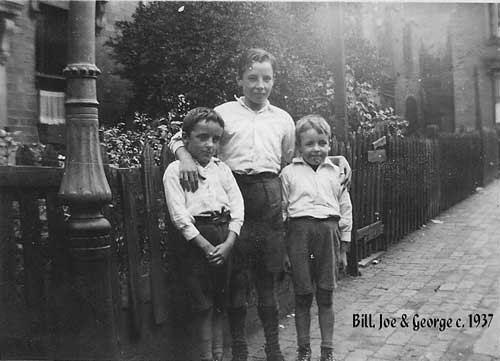 Whilst the Home Guard always took a very relaxed view of the regulation whereby members had to be of 17 years of age before they could be enlisted, this was a particularly early age and Joe must have been one of the very youngest to serve in the city, and perhaps anywhere else. Clearly several blind eyes must have been turned. This was Joe three years before he volunteered, flanked by his younger brothers Bill and George and probably standing outside their family home in Great Russell Street.
Whilst the Home Guard always took a very relaxed view of the regulation whereby members had to be of 17 years of age before they could be enlisted, this was a particularly early age and Joe must have been one of the very youngest to serve in the city, and perhaps anywhere else. Clearly several blind eyes must have been turned. This was Joe three years before he volunteered, flanked by his younger brothers Bill and George and probably standing outside their family home in Great Russell Street.
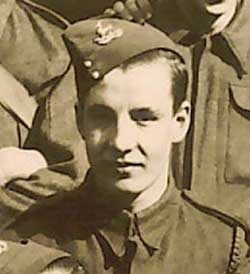
But by October 1941 he was showing remarkable maturity at the age of fifteen and looks older
(left) than some of the other lads shown in the group image which is reproduced further down this page.
Little is known about Joe's activities over the four years of his service, from December 1940 to stand-down in December 1944. What is certain is that for at least two years he would have been involved in the infantry activities of the Battalion or in some specialised role in support of such activities. Because of the urban nature of the area, that would have involved street fighting in the event of an emergency. In order to prepare for such duties Joe would have spent many hundreds of hours, at weekends and during evenings, being trained in weaponry, communication, streetfighting tactics, patrolling, camouflage 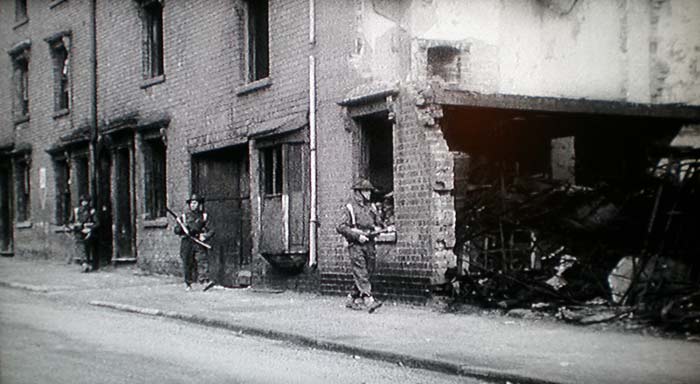 and all the other skills
intended to make him a successful infantryman. Exercises would have been conducted regularly
(see right); and simultaneously he would have been undertaking the normal, day-to-day functions of the Battalion: guarding, observing, patrolling, preparing defensive positions and so on.
and all the other skills
intended to make him a successful infantryman. Exercises would have been conducted regularly
(see right); and simultaneously he would have been undertaking the normal, day-to-day functions of the Battalion: guarding, observing, patrolling, preparing defensive positions and so on.
The early part of Joe's service would have been heavily influenced by the Birmingham Blitz which was at its height when Joe enlisted and would last in its most severe phase until May 1941 with sporadic attacks thereafter until July 1942. Many Home Guards were heavily involved in
assisting the other Civil Defence services in all the functions 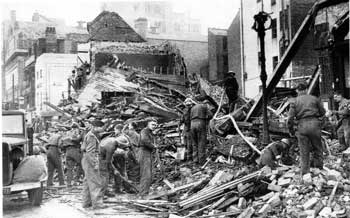 necessary
when a city is under attack and it is likely that Joe would have been among them. Stories abound and just a few of them, involving incredible bravery and self-sacrifice on the part of individual Home Guards, can be read within this website. For example, two members of Joe's own Battalion,
Alfred Brunges and CharlesTozer, were awarded the George Medal for outstanding bravery at a location near the Villa Cross cinema during a raid a few weeks earlier, on October 26th. Other pages dealing with those dreadful nights can be found by referring to the Warwickshire/Birmingham section index.
necessary
when a city is under attack and it is likely that Joe would have been among them. Stories abound and just a few of them, involving incredible bravery and self-sacrifice on the part of individual Home Guards, can be read within this website. For example, two members of Joe's own Battalion,
Alfred Brunges and CharlesTozer, were awarded the George Medal for outstanding bravery at a location near the Villa Cross cinema during a raid a few weeks earlier, on October 26th. Other pages dealing with those dreadful nights can be found by referring to the Warwickshire/Birmingham section index.
The raids had abated in the second half of 1941 when Nazi attention was concentrated on Russia following the attack in June and many of the bomber squadrons were sent from their French airfields to the East. (The story, probably typical, of one Luftwaffe bomber pilot who had attacked Birmingham several times is told
here). By then the 22nd Warwickshire (Birmingham) Battalion would have become a relatively efficient, trained fighting unit capable of giving a good account of itself in the event of enemy invasion or incursion. One of its constituent Companies, "E" Coy., is pictured here in a group photograph taken at an unknown location in October 1941. Joe is identified on it, although none of his other comrades has so far been named. (Go to the
magnified version to see the faces of individuals). The photograph, of high quality, was the work of H.J. Whitlock & Sons, a company which operated from 1843 until the 1960s, mainly from premises in New Street, Birmingham.
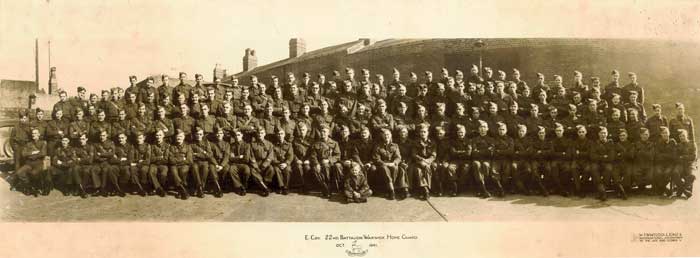
Click on the above image to see a greatly magnified version
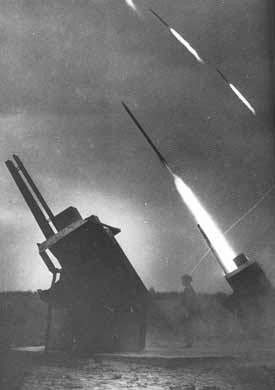 At the end of 1942 and in the early part of 1943, whilst the threat of invasion still existed and was taken seriously, the major fears of 1940 and 1941 had lessened to a significant extent. It was decided that the Home Guard's function could be extended to cover the manning of anti-aircraft batteries and so a large number of men were transferred out of the city infantry battalions to be trained and then act as gunners in cooperation with the Royal
At the end of 1942 and in the early part of 1943, whilst the threat of invasion still existed and was taken seriously, the major fears of 1940 and 1941 had lessened to a significant extent. It was decided that the Home Guard's function could be extended to cover the manning of anti-aircraft batteries and so a large number of men were transferred out of the city infantry battalions to be trained and then act as gunners in cooperation with the Royal 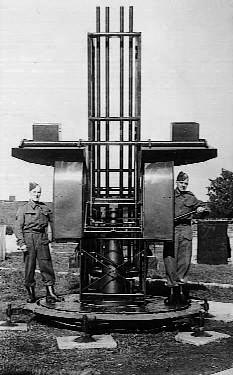 Artillery personnel at local batteries. Men could volunteer for this service but most were reluctant to leave their units where camaraderie and pride had developed to such a pitch over the previous two-and-a-half years; and so they had to be directed. The effect of this new Home Guard responsibility was to release Army personnel for other duties. Joe Bennett was one of those who found themselves spending the next 18 months or two years serving regular shifts as part of a team manning a huge anti-aircraft gun within a battery of several or, equally intimidating, one of the Z-battery multiple rocket launchers. We shall never know whether Joe's weapon was ever fired in anger. By that stage of the war, many were thankfully not (but perhaps to the disappointment of those faithfully and patiently manning them, night after night in summer and winter).
Artillery personnel at local batteries. Men could volunteer for this service but most were reluctant to leave their units where camaraderie and pride had developed to such a pitch over the previous two-and-a-half years; and so they had to be directed. The effect of this new Home Guard responsibility was to release Army personnel for other duties. Joe Bennett was one of those who found themselves spending the next 18 months or two years serving regular shifts as part of a team manning a huge anti-aircraft gun within a battery of several or, equally intimidating, one of the Z-battery multiple rocket launchers. We shall never know whether Joe's weapon was ever fired in anger. By that stage of the war, many were thankfully not (but perhaps to the disappointment of those faithfully and patiently manning them, night after night in summer and winter).
Joe's special insignia for his AA duties survives, as does the acknowledgement of his service.
The end of Joe's service with the Home Guard came, as did that of 1.75m other men and quite a few women, in early December 1944 when Home Guards throughout the country held their farewell parades on Sunday December 3rd. That service was recognised by his King George VIth certificate which happily survives within his family and is shown below.
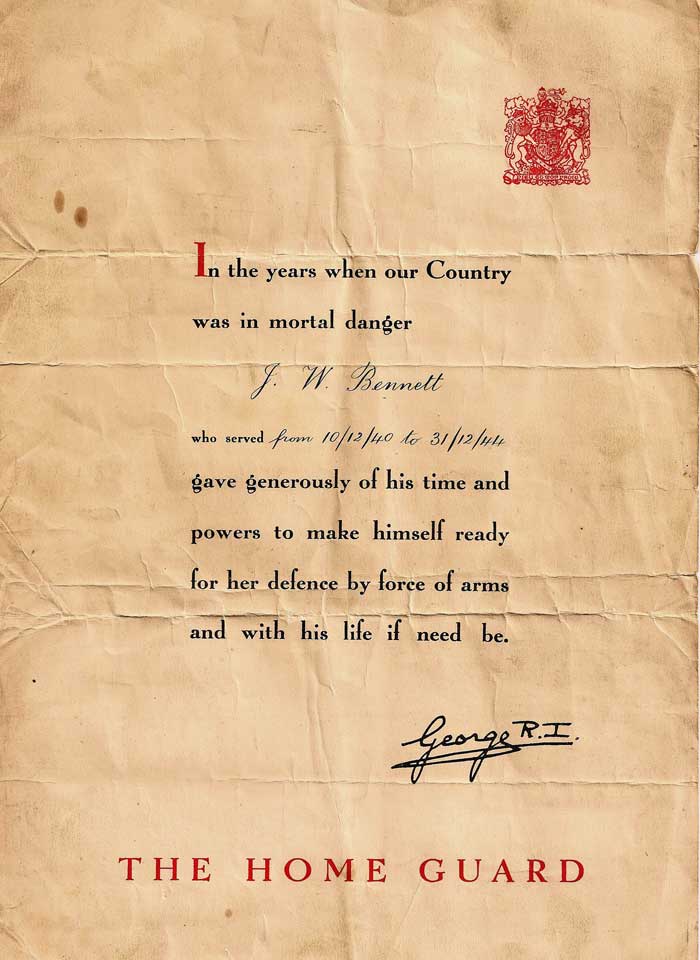
Other recognition followed:
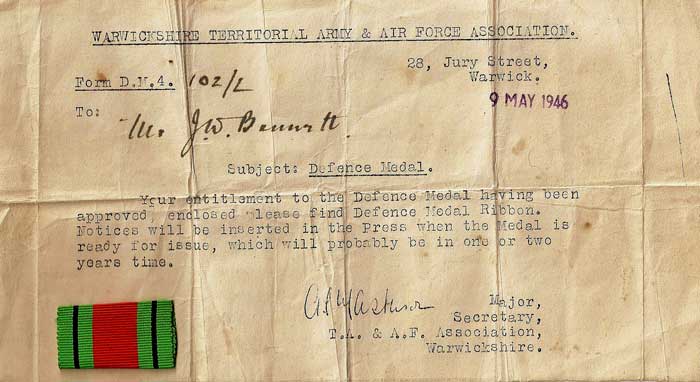
and, in due course, three medals including, centre, the War Medal 1939-1945 and, right, the Defence Medal:
Because of his remarkably young age at the time of enlistment, Joe had not been liable to call-up until the second half of 1944. But he was able to see his service right through to the end as he was in reserved employment, working as a toolmaker in an engineering company. The company was Halladay's Limited
of Tame Road, Witton and Joe worked there from 1940 to 1947.
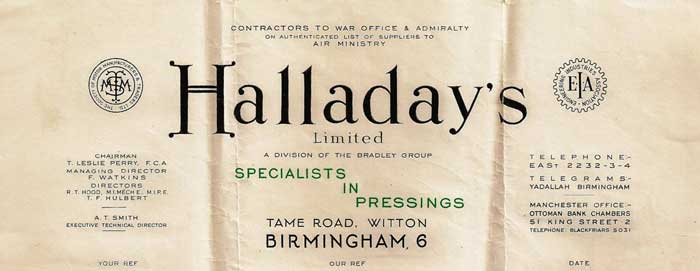
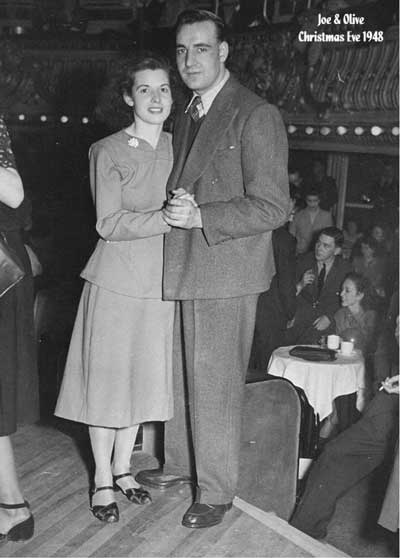
Joe's later life led to marriage in 1949 at St. Chad's Cathedral to
Olive Mary Brimson who had been born at
12 Sutherland Street, Aston and later lived at
35 Powick Road, Erdington. Here he is with Olive on Christmas Eve 1948, three months before their wedding.
By that time Joe was working at
Elkington and Co. Ltd. of Goscote Works, Walsall.
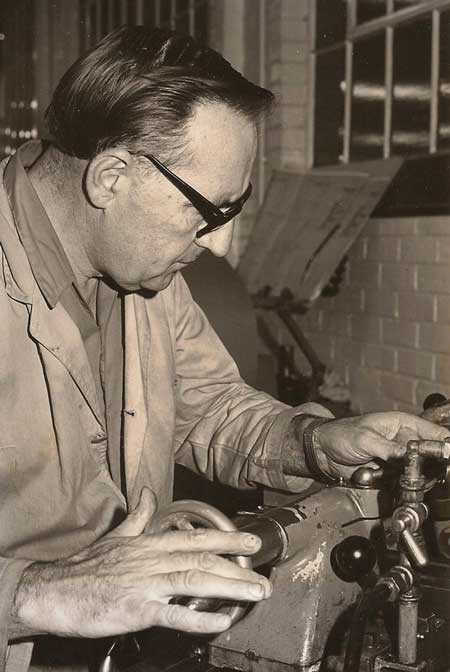
In 1952 he and Olive decided to emigrate to South Africa, partly for reasons of Olive's health. There the family extended to include two boys, Neil and John, whilst Joe himself worked in several engineering companies, still as a toolmaker
(right), until his retirement in 1992.
Regrettably he was only able to enjoy a short life in retirement; he died peacefully on 11th February 1994 and Olive survived him by a further seven years.
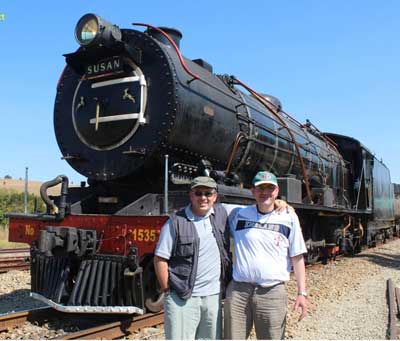 The two boys of the marriage are seen here at a happy reunion in March 2013
(Neil on the left, John right, standing in front of Susan).
The two boys of the marriage are seen here at a happy reunion in March 2013
(Neil on the left, John right, standing in front of Susan).
John has returned to his parents' roots: he emigrated to the UK and now lives in Handsworth, Birmingham.
Neil remains in South Africa; it is to him that we owe all the above information about his father which enables us to commemorate the service of one particular Home Guard, much younger than the vast majority but who, like the others, willingly gave thousands of hours of effort over four long years in order to help keep his family, his city and his nation safe.
***********
Sgt.
FRANCIS HOWARD GOODENOUGH
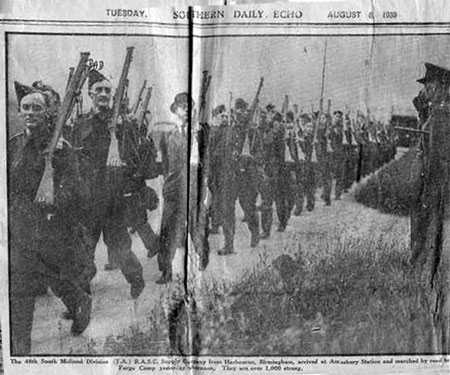 Much
less is known about another member of the 22nd
Warwickshire, Sgt. Francis Goodenough
(1909-1976) but a
few fragments indicating his Home Guard service survive
within his family.
Much
less is known about another member of the 22nd
Warwickshire, Sgt. Francis Goodenough
(1909-1976) but a
few fragments indicating his Home Guard service survive
within his family.
Sgt. Goodenough lived
during the war at
34 Wellington Street,
Ladywood, Birmingham. He was in the T.A. prior to the
outbreak of war in September 1939 and a contemporary
newspaper cutting shows him, just a month earlier, with
his 1000-men strong squad from the
48th South
Midland Division (T.A.) R.A.S.C. Supply Company. They
are seen shortly after arriving at Amesbury Station in
Wiltshire (from "Harbourne", Birmingham) and are
marching towards Forge Camp for whatever exercise awaits
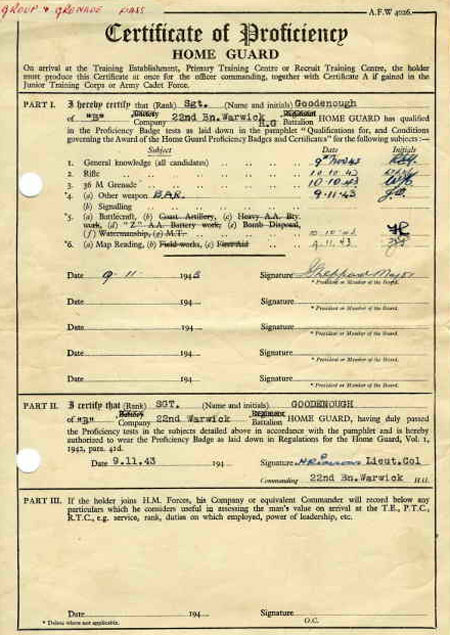 them.
them.
Thereafter, for several
years, his military activities are unknown. Despite his
T.A. involvement it appears that he did not serve in the
Regular Army but we can reasonably assume that he was an
early volunteer for the Home Guard who would have found
his previous experience invaluable. Not
surprisingly he had attained the rank of Sergeant by
1943 and was a member of "B" Coy.
The Certificate of Profiency dated 9th
November 1943 gives an indication of all the
infantryman's skills which he had gained, including
General Knowledge, Rifle, 36 M Grenade (the "Mills
Bomb"), the Browning Automatic Rifle, Battlecraft and
Map Reading and is countersigned by
Major I. Shepherd
(Company Commander) and
Lt.-Col. H. R. Parsons (Battalion C.O.)
***********
Please see also
the
remarkable story of the heroism of
Section Leader Alfred Brunges,
Patrol Leader Charles Tozer
and their comrades (of the 2nd Birmingham Battalion,
later the 22nd Warwickshire) on the night of 26th
October 1940.
And.....
the high
quality image of all the officers and NCOs of this
Battalion photographed in October 1944.
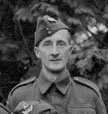 |
In Memory of
Pte. Joe Bennett
(right)
Sgt. Francis Goodenough
(left)
and of all
their comrades
serving in
22nd Warwickshire (Birmingham)
Battalion
1940 - 1944
|
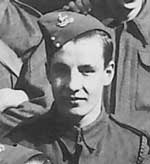 |
Acknowledgement
Grateful acknowledgement is made to Mr Neil Bennett of South Africa for providing this information about
Pte. Joe Bennett, his father, and generously permitting its publication;
and similarly to members of Francis Goodenough's family.
Personal images © Neil Bennett 2013
and © the Goodenough family
2017